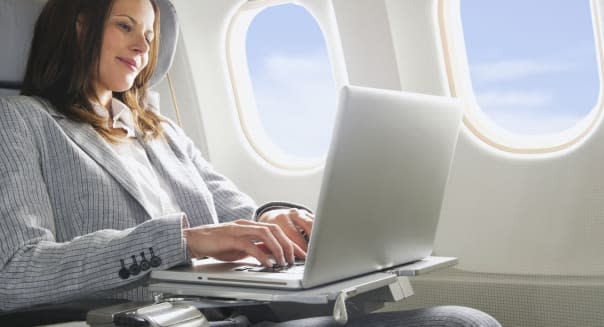Airlines Aren't Living Up to the Wi-Fi Promise

Taking to the friendly skies has never been more productive. More and more planes are being outfitted with Wi-Fi routers, affording passengers the option to surf the Web from their laptops, tablets and smartphones.
I've checked email, gone online shopping and even edited articles at 40,000 feet. It's merely a coincidence that SkyMall just filed for Chapter 11 bankruptcy reorganization, but options on a plane that offers Wi-Fi are no longer limited to leafing through a magazine as a reclining seat in front of you cramps up your living space.
Airborne connectivity is here. The problem is that it's not cheap, and more often than not, it's also not perfect.
Up, Up, and Away
New York Times tech reporter Nick Bilton recently ranted about the quality of in-flight Wi-Fi. Anyone who has paid up for connectivity has probably experienced the same sporadic outages that are far worse than Internet access on terra firma.
Gogo (GOGO) -- a publicly traded provider of in-flight Wi-Fi -- realizes that things can and will get better. Gogo Chief Technology Officer Anand Chari points out in Bilton's article that usage has spiked since it first began offering its platform several years ago.
When in-flight Wi-Fi first became available on commercial flights in 2008, there were no tablets, and smartphones were just starting to gain traction. Now Gogo has to deal with dozens of passengers trying to surf off the router at the same time.
This wouldn't be such a big deal if airborne access was free, but in most cases it's not. The third-party providers need to get paid, and in most cases the prices are high even without the air carriers getting in on the action the way that they do with other extra fees.
In-flight Wi-Fi fees vary based on carrier and distance, but they generally fall between $5 and $35 for the duration of the flight. Those living out of a suitcase can take advantage of passes that cover blocks of time. Gogo, for example, sells a monthly pass for $60.
A Need for Speed
In-flight Wi-Fi will have to battle the reliability issues and tackle passenger security concerns, but the more pressing need at the moment is speed. Chari reveals that as many as 70 passengers can be on its Wi-Fi platform on a flight between Boston and Los Angeles at any given time.
Gogo has to move fast, and not just because it has yet to turn profitable. It announced last week that it has a backlog of 1,000 commercial planes to get connected. It plans to grow its fleet by 500 aircraft in 2015, reaching a total of 2,600 by year's end. It's in the process of updating older systems with a new air-to-ground solution that triples peak speeds, but it's aiming even higher.
Later this year it will introduce 2Ku, a global satellite solution that delivers peak speeds that are 20 times faster than its original air-to-ground solution. As long as the rates for the new platforms don't increase significantly, it could be just what the industry needs to finally deliver the fast and reliable connections that passengers think they are paying for before settling for less.
Motley Fool analyst Rick Munarriz has no position in any stocks mentioned. The Motley Fool has no position in any of the stocks mentioned. Try any of our Foolish newsletter services free for 30 days. To read about our favorite high-yielding dividend stocks for any investor, check out our free report.

